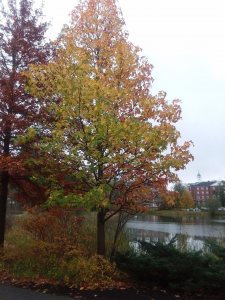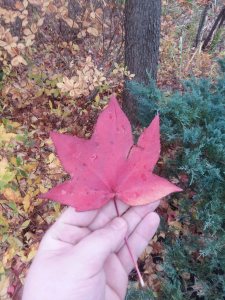Sweetgum
Liquidambar styraciflua | Family: Altiniaceae
Submission: Brian Wauford ‘19
Sweetgum (Liquidambar stryaciflua) is a tree that has a lot of wonderful uses for people. Although the fruit from this tree is not an agricultural product, sweetgum still has a multitude of merits that make it a great tree to have around. It is very popular for plywood veneer, meaning it has a good-looking grain that can be placed in a thin sheet over furniture that is made from cheaper, less attractive wood. Everybody likes something that is cheap and looks good! It is not just called sweetgum for nothing, the name is derived from “storax flow” because of the sap that leaks from the wounded bark. In the past, this sap has been used for the production of chewing gum. Nowadays, the resin (which also has a fragrant smell) is used for perfume and soaps.
Aside from making soaps and gum, the tree is also used for medicinal purposes. The bark can be used for its astringent qualities, the fruits can help with rheumatic pain, the resin has anti-inflammatory properties which have been used in the past to help with bed-sores, and the Cherokee Native Americans used the sap to heal wounds.
Sweetgum has beautiful bright red foliage in the fall as well as corky twigs, which make this tree aesthetically pleasing. Because of this, they are often planted on private lands and public parks. Moreover, the leaves are an amazing star shape,, which is not too common among trees in New England. The aforementioned qualities all make sweetgum the superstar of trees.
If you like cute furry animals, consider a sweetgum tree in your yard. Animals that use sweetgum for canopy cover include squirrels, wood ducks, white-tailed deer, and beavers. They can also be used ecologically to reclaim former zinc and phosphorus mines because they are fast growing and resistant to insect attacks. People may also refer to sweetgum as redgum, storax, alligator wood or star-leaved gum.
Leaves – simple, deciduous, alternate, star-shaped, palmately 5-7 lobed; finely serrate; lobes with acuminate apex; leaf with truncate base.
Twigs – shiny; aromatic; commonly with corky ridges; buds with several orange-brown imbricate scales.
Fruit – 1” diameter, globose head of 2-celled beaked (spiny) capsules; mature in fall; the empty fruits often persistent through winter.
Bark – grayish brown; furrowed, with narrow, rounded, flaky ridges.
Silvics – A large, intolerant tree on a variety of sites (mainly bottomlands) on the piedmont and coastal plains; commonly reproduces vegetatively by root suckering.
References:
Brockman, C.F. 1986. Trees of North America: A Guide to Field Identification. Revised Edition. Western Pub. Co., Inc. 280pp.
Elias, T.S. 1980. The Complete Trees of North America Field Guide and Natural History. Van Nostrand Reinhold Co., N.Y. 948pp.
Harlow, W.M., Harrar, E.S., Hardin, J.W. and White, F.M. 1991. Textbook of Dendrology. McGraw-Hill Inc., N.Y. 501pp.
Petrides, G.A. 1972. A Field Guide to Trees and Shrubs. 2nd edition. Houghton Mifflin Co., Boston. 428pp.
Preston, R.J., Jr. 1989. North American Trees. 4th edition. Iowa State Univ. Press. Ames. 407pp.
Shane, J. 2004. Dendrology Handbook, University of Vermont, Unpublished.
Tree-guide.com: Sweetgum. Jowaca Digital Solutions; [accessed November 2, 2017]. Part of the World Leaf Project. http://www.tree-guide.com/sweetgum

